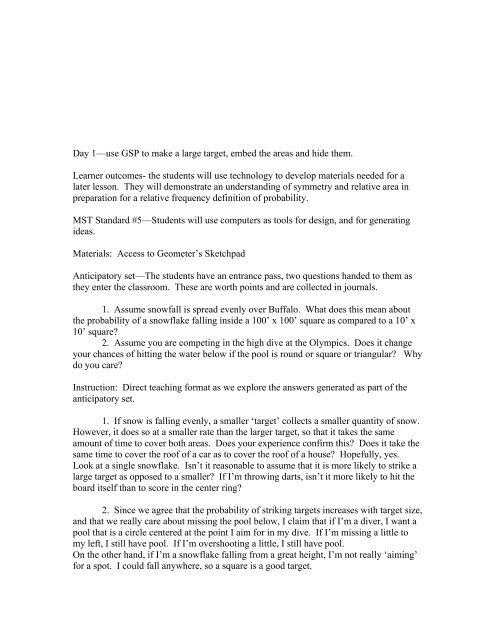MED 607/I2T2 Projectâ5 day lesson plan on geometric probability ...
MED 607/I2T2 Projectâ5 day lesson plan on geometric probability ...
MED 607/I2T2 Projectâ5 day lesson plan on geometric probability ...
- No tags were found...
Create successful ePaper yourself
Turn your PDF publications into a flip-book with our unique Google optimized e-Paper software.
Day 1—use GSP to make a large target, embed the areas and hide them.Learner outcomes- the students will use technology to develop materials needed for alater <str<strong>on</strong>g>less<strong>on</strong></str<strong>on</strong>g>. They will dem<strong>on</strong>strate an understanding of symmetry and relative area inpreparati<strong>on</strong> for a relative frequency definiti<strong>on</strong> of <strong>probability</strong>.MST Standard #5—Students will use computers as tools for design, and for generatingideas.Materials: Access to Geometer’s SketchpadAnticipatory set—The students have an entrance pass, two questi<strong>on</strong>s handed to them asthey enter the classroom. These are worth points and are collected in journals.1. Assume snowfall is spread evenly over Buffalo. What does this mean aboutthe <strong>probability</strong> of a snowflake falling inside a 100’ x 100’ square as compared to a 10’ x10’ square?2. Assume you are competing in the high dive at the Olympics. Does it changeyour chances of hitting the water below if the pool is round or square or triangular? Whydo you care?Instructi<strong>on</strong>: Direct teaching format as we explore the answers generated as part of theanticipatory set.1. If snow is falling evenly, a smaller ‘target’ collects a smaller quantity of snow.However, it does so at a smaller rate than the larger target, so that it takes the sameamount of time to cover both areas. Does your experience c<strong>on</strong>firm this? Does it take thesame time to cover the roof of a car as to cover the roof of a house? Hopefully, yes.Look at a single snowflake. Isn’t it reas<strong>on</strong>able to assume that it is more likely to strike alarge target as opposed to a smaller? If I’m throwing darts, isn’t it more likely to hit theboard itself than to score in the center ring?2. Since we agree that the <strong>probability</strong> of striking targets increases with target size,and that we really care about missing the pool below, I claim that if I’m a diver, I want apool that is a circle centered at the point I aim for in my dive. If I’m missing a little tomy left, I still have pool. If I’m overshooting a little, I still have pool.On the other hand, if I’m a snowflake falling from a great height, I’m not really ‘aiming’for a spot. I could fall anywhere, so a square is a good target.
















